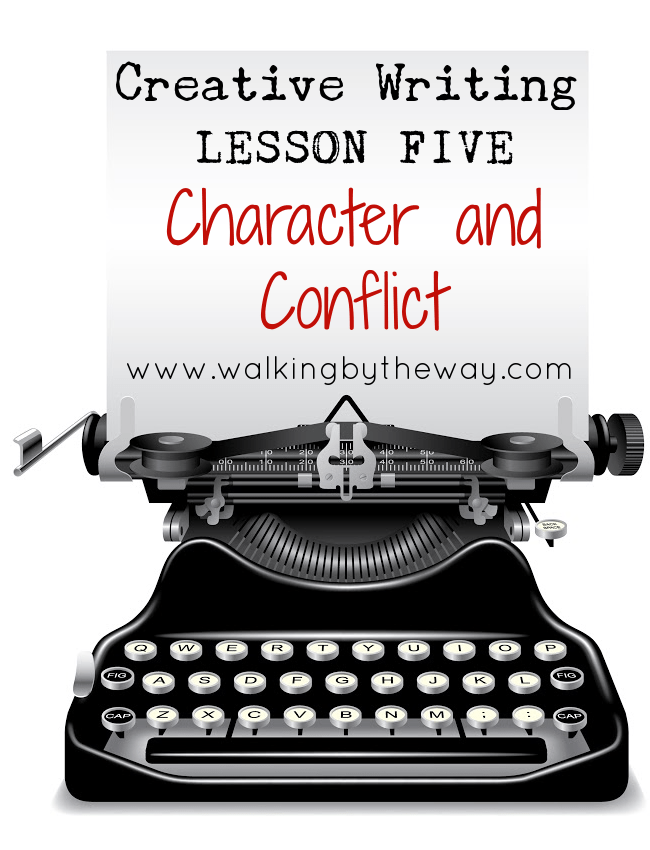
When I first began crafting these creative writing lessons, it was difficult.
I would only have nine weeks with my students. Just nine chances to promote a love for writing, to stretch their brains, and to pour into their creative writing cups. Fill them up but don’t drown them.
I determined I would spend the first four weeks on the basics of poetry and prose. The fifth week, we started studying the short story. We started with character and conflict.
Note: You could easily break this lesson into two lessons. The only reason I jammed them together is because of time.
Writing Strong Characters and Conflicts
In this fifth creative writing lesson, we reviewed the story elements of character and conflict.
1. Read, review, analyze homework assignments from week three. (Yes, we looked at the good, the bad, and the ugly.)
2. Discussed Strong Characters
I asked my students these questions: Who’s your favorite literary character? Why? What do you know about your character? Is your favorite character like you or not like you? How?
We used our discussion to determine what writers need to do in order to create interesting and believable characters.
3. Discussed Strong Conflicts
Conflict. What is conflict? Conflict is a struggle between opposing forces. A strong conflict moves the plot forward.
Stories need conflict. Why? Because conflict is part of the human experience. Ask your students, “What conflicts have you endured already today?”
Using the printable page, we outlined three different types of conflict (man vs. man, man vs. nature, and man vs. self).
Different curricula teach different kinds of conflict, but I focus on these three basic types of conflict. I mentioned to my students that there are other categories (man vs. society, man vs. God, man vs. technology, etc.).
I read three picture books to the students:
- Fortunately by Remy Charlip
- The Sneetches by Dr. Seuss
- Albert by Donna Jo Napoli.
After each book, students determined which types of conflict were present in the story.
What books are your student currently reading at home? What conflicts are in those books? What makes a conflict strong? A good conflict needs to be relatable.
If you want to extend this lesson on conflict, you can check out a stack of picture books from your local library and give each student a book. Give students time to read and determine the conflict(s) and report back to the class.
4. Character Auction
Students brought character cards to class (from their Week Four homework). I gave them each an additional index card and two minutes to invent another character.

I gave each student $100 in play money, and we had a character auction. The characters purchased would play a part in next week’s homework assignments.
Once I read all the character names and descriptions, students started bidding. They were not allowed to bid on their own.
Everyone had to snag two characters.
Warning: These auctions always bring out the beast in my students!

As each character is sold, the student responsible for creating the character gets paid the auction price.
The person with the most money at the end of the auction, gets a prize. (usually a giant candy bar or a $5 Starbucks gift card)
5. We discussed the homework assignments for the next week. As I do this, I give students a chance to ask questions. I don’t want any “I didn’t understand” excuses when it’s time to collect homework.
Creative Writing Lesson Printables for Character and Conflict
If you’d like a copy of the printables I used for this creative writing lesson, simply click on the image below.
It includes the homework, the types of conflict page (to take notes during the lecture), and a page to record conflict scenarios for a short story.
More Creative Writing Lessons
If you are looking for more creative writing lessons, try these:
- Creative Writing Lesson 1
- Creative Writing Lesson 2
- Creative Writing Lesson 3
- Creative Writing Lesson 4
- Creative Writing Lesson 6
- Creative Writing Lesson 7
- Creative Writing Lesson 8
Happy Writing!


These are wonderful! How can I subscribe/follow your blog??
Thank you!
In the upper right corner, there is an orange RSS feed button. It takes you to this place:
http://feeds.feedburner.com/walkingbtw
Does that help? 🙂